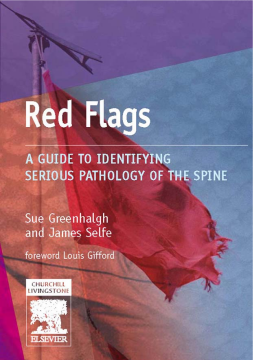
Additional Information
Book Details
Abstract
This title is directed primarily towards health care professionals outside of the United States. This valuable clinical reference alerts practitioners to potentially serious indicators of pathology in their patients, such as cancer, tuberculosis (TB), or other conditions. With a fresh approach to the subject, it presents an hierarchy of red flags, an index of suspicion, discussion of red herrings, "3D thinking," and conditional probabilities intended to assist with clinical reasoning. It's an ideal, on-the-spot resource for anyone involved in the care of patients with musculoskeletal conditions.
- The book's small, portable size makes it ideal for reference in any practice setting.
- Two-color layout presents information in an accessible, at-a-glance format.
- The unique red flag hierarchy assists with clinical reasoning.
- Index of Suspicion highlights the most likely conditions indicated by specific red flags.
- Discussion of 3D thinking encourages clinicians to look beyond immediate symptoms to find the underlying cause of a problem.
- Discussion of red herrings describes how to approach indicators that may mislead a diagnosis.
- Information on the concept of conditional probabilities helps practitioners make informed clinical decisions.
Table of Contents
| Section Title | Page | Action | Price |
|---|---|---|---|
| Front Cover | Cover | ||
| Red Flags: A Guide to Identifying Serious Pathology of the Spine | iii | ||
| Contents | v | ||
| Foreword | ix | ||
| Acknowledgements | xiii | ||
| Introduction | 1 | ||
| Chapter 1. Red Flags | 5 | ||
| Historical perspective of physiotherapy | 7 | ||
| Early development of indicators of serious pathology | 8 | ||
| Clinical guidelines | 14 | ||
| Red Herrings and masqueraders | 20 | ||
| Some pathologies appearing on Red Flag lists | 25 | ||
| Conclusion/summary | 42 | ||
| Chapter 2. Clinical Reasoning | 49 | ||
| Pain, behaviour and psychosocial flags | 51 | ||
| Clinical reasoning | 58 | ||
| Health behaviour | 73 | ||
| Summary | 77 | ||
| Weighted Red Flag list | 81 | ||
| Chapter 3. Subjective Examination: Age, Previous Medical History and Lifestyle Questions | 89 | ||
| Age | 91 | ||
| Medical history | 96 | ||
| Lifestyle | 108 | ||
| Chapter 4. Subjective Examination: Questions about the Current Episode and Pain | 115 | ||
| History of current episode questions | 117 | ||
| Pain questions | 135 | ||
| Extract from a patient–clinician consultation | 143 | ||
| Chapter 5. Objective Examination | 171 | ||
| Physical appearance | 172 | ||
| Inability to lie supine | 174 | ||
| Bizarre neurological deficit | 175 | ||
| Marked partial articular restriction of movement | 178 | ||
| Loss of sphincter tone and altered S4 sensation | 178 | ||
| Spasm | 179 | ||
| Vertebral artery testing | 179 | ||
| Upper cervical instability tests | 181 | ||
| Positive extensor plantar response | 183 | ||
| Disturbed gait | 184 | ||
| Summary | 185 | ||
| Chapter 6. Conclusion | 191 | ||
| Hierarchical list of Red Flags | 192 | ||
| Red Flags not Red Herrings – the clinician’s perspective | 193 | ||
| Index | 201 |
